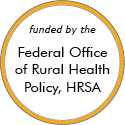Maryland Models and Innovations
These stories feature model programs and successful rural projects that can serve as a source of ideas. Some of the projects or programs may no longer be active. Read about the criteria and evidence-base for programs included.
Effective Examples
Regional Oral Health Pathway

Updated/reviewed August 2023
- Need: To address the oral health needs of low-income uninsured and underinsured residents in rural Appalachia.
- Intervention: An oral health education program was implemented in Appalachian Maryland, Pennsylvania, and West Virginia.
- Results: This program increased oral health visits in the area and provided residents with valuable information on oral health resources and services.
Promising Examples
Maryland Faith Health Network
Updated/reviewed December 2022
- Need: To coordinate formal and informal community-based caregivers for optimal patient experience.
- Intervention: The Maryland Faith Health Network unites places of worship and healthcare systems in Maryland. This program aims to decrease the amount of potentially avoidable hospitalizations, improve a patient's overall wellness, and cut down on the cost of medical services.
- Results: This model is currently running in 3 hospitals that serve both rural and urban residents in central Maryland. So far, 1,300 congregants from 70 congregations representing Christian, Jewish, and Muslim faiths have enrolled in the Network.
Atlantic General Hospital Patient Centered Medical Home
Updated/reviewed August 2022
- Need: Ways to reduce hospital admission rates, emergency department visits, and total cost of care while better accommodating patients of the Atlantic General Hospital Corporation.
- Intervention: The hospital system applied a patient centered medical home care model to their 7 rural outpatient clinics located throughout the Eastern Shore of Maryland and southern Delaware.
- Results: From the program's care coordination, care transitions, and intervention efforts, AGH saw improvements in quality-of-care processes, service use, and spending.
Other Project Examples
The Possibility Shop
Updated/reviewed January 2024
- Need: To connect vulnerable populations in Allegany County, Maryland, to health and human services and to items like hygiene products, food, and clothing.
- Intervention: The Possibility Shop partners with health organizations, insurance navigators, food banks, and other agencies.
- Results: In 2023, 8,684 service encounters occurred and 501 intakes to services were performed.
CAPABLE (Community Aging in Place—Advancing Better Living for Elders)
Updated/reviewed July 2023
- Need: To help older adults age in place.
- Intervention: For five months, CAPABLE participants receive home visits from a registered nurse, occupational therapist, and home repair services.
- Results: There are currently over 35 CAPABLE sites across the country, 11 of which are located in rural communities.
Clinic for Special Children
Updated/reviewed July 2023
- Need: To provide healthcare for the genetically vulnerable children and adults of the rural, uninsured Amish and Mennonite communities in southern Pennsylvania.
- Intervention: A clinic that serves as a comprehensive medical practice for children and adults (primarily from the Amish and Mennonite communities) with rare, inherited, or complex disorders.
- Results: In 2022, about 1,400 active patients with more than 400 unique genetic mutations were treated at the Clinic for Special Children.
Queen Anne's County Mobile Integrated Community Health (MICH) Program
Updated/reviewed April 2023
- Need: To connect patients to resources in order to reduce use of emergency services, emergency department visits, and hospital readmissions.
- Intervention: Patients receive support (by in-person visit, phone call, or telehealth visit) from a paramedic, community health nurse, peer recovery specialist, and pharmacist.
- Results: Between July 2016 and June 2019, the MICH program enrolled 233 patients and demonstrated a total savings of $3,393,908 in healthcare costs.
Garrett County Regional Cancer Patient Navigator Program

Updated/reviewed March 2020
- Need: Comprehensive cancer services for residents of an 8-county, 3-state area in Appalachia.
- Intervention: Using a Cancer Patient Navigation Tool Kit, a Maryland acute care facility led a multidisciplinary collaboration that provided the area's patients with expanded cancer treatment services.
- Results: In addition to several new cancer-related programs, expanded services are now available for cancer patients, families, and cancer survivors.
Last Updated: 1/23/2024

